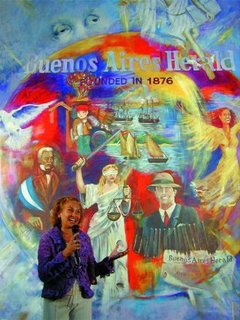Mural
Donderdag werd een muurschildering ter viering van het 130-jarig bestaan van de Herald aan het publiek getoond. Aan mij de eer om er een stukje over te schrijven. The triumphant tones of New York, New York, rang in the ears of pedestrians on Azopardo street Thursday evening, as the Coast Guard's brass band played in front of the Buenos Aires Herald offices. The bands presence, a gift from the maritime authorities, marked the unveiling of a mural painted especially for the papers's 130th anniversary.
The triumphant tones of New York, New York, rang in the ears of pedestrians on Azopardo street Thursday evening, as the Coast Guard's brass band played in front of the Buenos Aires Herald offices. The bands presence, a gift from the maritime authorities, marked the unveiling of a mural painted especially for the papers's 130th anniversary.
Guests ranged from members of the Anglo-Argentine community and some of the Herald's neigbours to the Coasts Guard's top brass and a handful of friends of the artist. Of course many members of the Herald staff, their friends and family were among those present. The main focus of the celebration was on the enormous mural, which was unveiled after the band played the national anthem. Those who have walked along Azopardo street in the past few weeks will already be familiar with the colourful work of art on the office's eastern facing wall, but for those present artist Zulma Garcia Cuerva explained what the mural was all about.
The main focus of the celebration was on the enormous mural, which was unveiled after the band played the national anthem. Those who have walked along Azopardo street in the past few weeks will already be familiar with the colourful work of art on the office's eastern facing wall, but for those present artist Zulma Garcia Cuerva explained what the mural was all about.
"When I saw the wall and thought of a newspaper, the idea of Borges' story of The Aleph came to mind", she said, referring to Argentine writer's collection of short stories. "The idea of a newspaper as a universe where everything happens at once appealed to me."
To be able to depict that all-encompassing view Garcia Cuerva, who was aided in the actual painting by Cora Michudis, chose a number of different symbols. "To the left there's Peace and Justice," she said pointing to the white dove and the blindfolded female wielding a sword and scales. "The woman to the right in a yellow dress represents Freedom."
One of the figures is a sad looking boy holding what looks like a number of newspapers. "The boy is Juan Laguna or Juan Limosna, a subject often painted by Berni," Garcia Cuerva told the Herald, drawing a parellel between the famous painters controversial choice to depict the misery of the urban poor and the critical stance taken by the Buenos Aires Herald on many important issues. "Juanito Limosna is not a beggar," she explained, "he is demanding justice."
At the top of the mural a leaping Hermes, the Greek messenger god, delivers copies of the newspaper. "Herald is term derived from Hermes," the artist went on to say. The two enormous eyes to the left belong to Borges, the original inspiration for the design.
"We decided on a mural because its a graphic way of explaining what a newspaper is all about," said a visibly chuffed Herald president Gabriel Mysler. "That way people passing by have a sense of what we do." Together with the artist and with Herald colleague Fernanda Gonzalez, he planned the mural and it's festive unveiling "It won't make the world a better place," he added, "but it will make it a better place to look at."
Looking back on on its 130 year history The Buenos Ayres Herald — as it was originally spelled, has come a long way since an elderly Scot named William Cathcart founded the paper. Compared to today's paper it was a simple, straightforward affair. Just a single sheet of paper with advertising on the front and mostly shipping coverage on the back.
Since then the paper has grown to become a reliable daily appearing more than 360 days a year without fail for the past nine decades. Along the way the paper has earned an interntational reputation and recieved a number of distinguishing awards, especially for its independent reporting amid the state and guerrilla terrorism of the 1970's.
All the while the Buenos Aires Herald has been a mainstay for the Anglo-Argentine community, as former Hurlingham Club president Eric Campbell testified during the unveiling. "Its an institution and part of British community life," he told the Herald
. "I simply don't know what the h*ll we'd do without it." He also applauded the international newscoverage, saying it was a pleasant surprise to many international visitors. "When my nephew from Britain first read the Herald he was tickled pink to find all the news he needed," said Campbell.
Angel Alberto Navarro of Argentina's Coast Guard reminded the Herald of the longstanding friendship between the port authorities and the newspaper with a strong maritime tradition. "Our history goes back 196 years," Navarro said of the Prefectura Naval, "for 130 of those we've had close ties with the Herald."
In his remarks to the gathered crowd in front of the mural, Gabriel Mysler also spoke of importance of a international trade in the newspapers' history. Asked how it was possible that a small English language newspaper had managed to survive 13 of the most turbulent decades of Argentine history, Mysler answered, "its a miracle!".

1 Comments:
Hey Paul!!!!
Leuk om te lezen dat alles goed met je gaat! In je oude vertrouwde Den Haag loopt het ook prima... Zij het dat het op de burelen van AD/HC erg stil is als gevolg van je afwezigheid.
Houd je haaks, daar op de pampa!
Maarten
12:25 PM
Post a Comment
<< Home